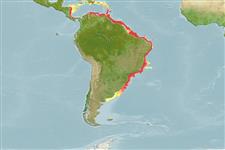Common names from other countries
>
Eupercaria/misc (Various families in series Eupercaria) >
Sciaenidae (Drums or croakers)
Etymology: Cynoscion: Greek, kyon = dog + Greek, odous = teeth + Greek, skion, skiaina = barbel, red mullet (Ref. 45335).
More on authors: Vaillant & Bocourt.
Environment: milieu / climate zone / depth range / distribution range
Sinh thái học
Biển; Thuộc về nước lợ gần đáy; Mức độ sâu 1 - 70 m (Ref. 9626), usually 18 - 55 m (Ref. 9626). Subtropical; 18°N - 52°S, 83°W - 34°W
Western Atlantic: Panama and the Greater Antilles to Argentina. Including Lesser Antilles (Ref. 26938). Also reported in Nicaragua (Ref. 13613).
Length at first maturity / Bộ gần gũi / Khối lượng (Trọng lượng) / Age
Maturity: Lm 25.1, range 15 - ? cm
Max length : 56.9 cm TL con đực/không giới tính; (Ref. 125970); common length : 35.0 cm TL con đực/không giới tính; (Ref. 3702); Khối lượng cực đại được công bố: 2.2 kg (Ref. 125970)
Các tia vây lưng cứng (tổng cộng) : 11; Các vây lưng mềm (tổng cộng) : 23 - 27; Tia cứng vây hậu môn: 2; Tia mềm vây hậu môn: 9. Colour greyish above, silvery below. Without conspicuous spots, but with faint dark streaks along scale rows above lateral line. Pectoral-fin bases and upper rays slightly dark, pelvic and anal fins often yellowish, dorsal and caudal fins dusky with darker margin. Inside opercle darkish visible externally. Mouth large, oblique, lower jaw slightly projecting. Upper jaw with a pair of large canine-like teeth at tip. Chin without barbel or pores, snout with only 2 marginal pores. Gas bladder with a pair of horn-like anterior appendages. Sagitta (large earstone) moderately broad and thick, Lapillus (small earstone rudimentary. Scales large. Soft portion of dorsal-fin base covered with small scales up to 1/2 of fin height (Ref 51721).
Found over sand or mud bottoms from the coastline to about 60 m depth (Ref. 3702); rarely in waters with a depth of less than 18 m (Ref. 9626). Juveniles inhabit river estuaries (Ref. 3702). Oviparous, with high fecundity (Ref. 54358). Feed on fishes and crustaceans like crabs and shrimps (Ref. 35237). Important food fish (Ref. 3702).
Cervigón, F., 1993. Los peces marinos de Venezuela. Volume 2. Fundación Científica Los Roques, Caracas,Venezuela. 497 p. (Ref. 9626)
IUCN Red List Status (Ref. 130435)
CITES (Ref. 128078)
Not Evaluated
Threat to humans
Harmless
Human uses
Các nghề cá: Tính thương mại; cá để chơi: đúng
Các công cụ
Special reports
Download XML
Các nguồn internet
Estimates based on models
Preferred temperature (Ref.
115969): 11.3 - 27.9, mean 22.4 (based on 376 cells).
Phylogenetic diversity index (Ref.
82804): PD
50 = 0.5000 [Uniqueness, from 0.5 = low to 2.0 = high].
Bayesian length-weight: a=0.00741 (0.00614 - 0.00895), b=3.07 (3.05 - 3.09), in cm Total Length, based on LWR estimates for this species (Ref.
93245).
Mức dinh dưỡng (Ref.
69278): 3.8 ±0.66 se; based on food items.
Thích nghi nhanh (Ref.
120179): Chiêù cao, thời gian nhân đôi của chủng quần tối thiểu là dưới 15 tháng (Fec = 47,000).
Prior r = 1.00, 95% CL = 0.66 - 1.50, Based on 1 data-limited stock assessment.
Fishing Vulnerability (Ref.
59153): Low to moderate vulnerability (32 of 100).
